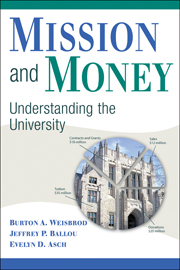Book contents
- Frontmatter
- Contents
- Illustrations
- Preface
- 1 An Introduction to the Higher Education Industry
- 2 The Higher Education Business and the Business of Higher Education – Now and Then
- 3 Is Higher Education Becoming Increasingly Competitive?
- 4 The Two-Good Framework: Revenue, Mission, and Why Colleges Do What They Do
- 5 Tuition, Price Discrimination, and Financial Aid
- 6 The Place of Donations in Funding the Higher Education Industry
- 7 Endowments and Their Management: Financing the Mission
- 8 Generating Revenue from Research and Patents
- 9 Other Ways to Generate Revenue – Wherever It May Be Found: Lobbying, the World Market, and Distance Education
- 10 Advertising, Branding, and Reputation
- 11 Are Public and Nonprofit Schools “Businesslike”? Cost-Consciousness and the Choice between Higher Cost and Lower Cost Faculty
- 12 Not Quite an Ivory Tower: Schools Compete by Collaborating
- 13 Intercollegiate Athletics: Money or Mission?
- 14 Mission or Money: What Do Colleges and Universities Want from Their Athletic Coaches and Presidents?
- 15 Concluding Remarks: What Are the Public Policy Issues?
- Appendix
- References
- Index
7 - Endowments and Their Management: Financing the Mission
Published online by Cambridge University Press: 17 July 2009
- Frontmatter
- Contents
- Illustrations
- Preface
- 1 An Introduction to the Higher Education Industry
- 2 The Higher Education Business and the Business of Higher Education – Now and Then
- 3 Is Higher Education Becoming Increasingly Competitive?
- 4 The Two-Good Framework: Revenue, Mission, and Why Colleges Do What They Do
- 5 Tuition, Price Discrimination, and Financial Aid
- 6 The Place of Donations in Funding the Higher Education Industry
- 7 Endowments and Their Management: Financing the Mission
- 8 Generating Revenue from Research and Patents
- 9 Other Ways to Generate Revenue – Wherever It May Be Found: Lobbying, the World Market, and Distance Education
- 10 Advertising, Branding, and Reputation
- 11 Are Public and Nonprofit Schools “Businesslike”? Cost-Consciousness and the Choice between Higher Cost and Lower Cost Faculty
- 12 Not Quite an Ivory Tower: Schools Compete by Collaborating
- 13 Intercollegiate Athletics: Money or Mission?
- 14 Mission or Money: What Do Colleges and Universities Want from Their Athletic Coaches and Presidents?
- 15 Concluding Remarks: What Are the Public Policy Issues?
- Appendix
- References
- Index
Summary
Although tuition, donations, and research all bring in revenue, many colleges and universities generate additional, and in some cases substantial, funds from managing their endowment funds. Although endowments are typically restricted – the university cannot simply decide to spend all of the endowment in a single year – prudent management would preserve funds for the future even if there were no restrictions whatsoever, and so the management of endowment wealth remains a material piece of the mosaic of university finance: the pursuit of revenue and mission.
Endowment size varies tremendously in higher education. The wealthiest schools are large even by the standards of the business world: Harvard's $34.6 billion endowment in 2007 is comparable to the market value of Burlington Northern (ranked 110 in the S&P 500), Aetna (ranked 119), or Colgate-Palmolive (ranked 72). Even the eighteenth largest endowment in 2007, Cornell University, exceeded $5 billion, a requirement for listing in the S&P 500 and on par with the market value of Aramark (Forbes.com 2006). The schools with the largest endowments are the ones that everyone recognizes – and not coincidentally. Large endowments are both a driver and a reflection of university growth and prestige.
These wealthy schools are rare, however. The vast majority of schools have endowments that are measured in tens of millions or less, not in billions. And schools with large endowments invest them very differently than do schools with small endowments, generating systematically different rates of return.
- Type
- Chapter
- Information
- Mission and MoneyUnderstanding the University, pp. 130 - 148Publisher: Cambridge University PressPrint publication year: 2008

